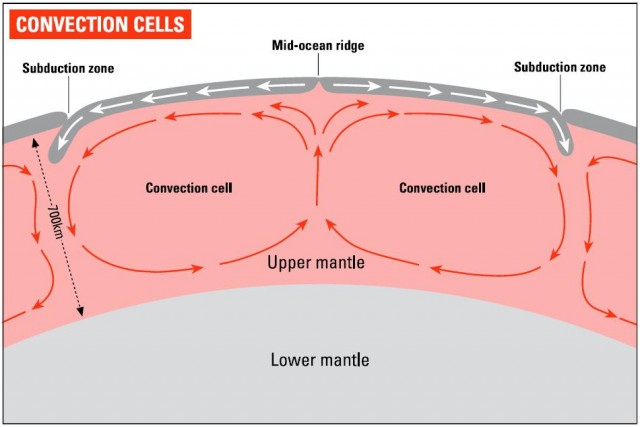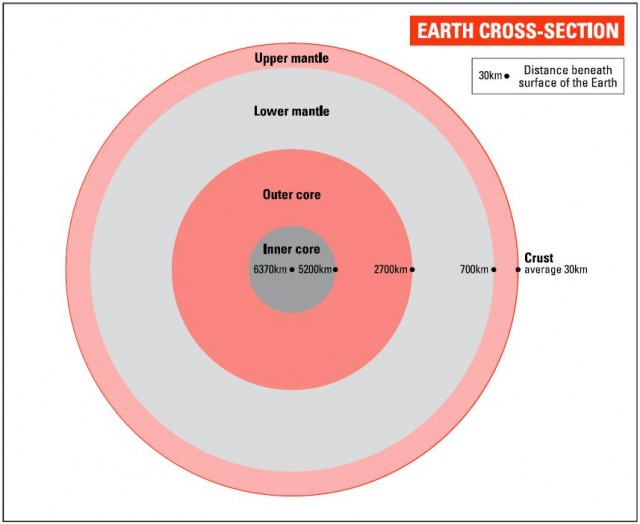The mantle
It is not only rock density that changes at the Mohorovicic Discontinuity. It is also marked by severe changes in rock composition. Above it we find the rocks we know from surface-based geology. Below, we enter a new world.
The boundary between the crust and the mantle below is no hermetic seal, however. It is more like something out of biology, maybe the stomach wall, an important but permeable boundary across which there is lively trade. The Earths crust and mantle are constantly interacting, and we have the rocks to prove it. In numerous parts of the Earths surface, volcanoes bring small pieces of the mantle to the surface. At mid-ocean ridges, much larger volumes of mantle rock can appear.
But there are limits to how much these rocks can tell us about the deep Earth. As material from the mantle rises towards the surface, it melts because the pressure drops. But it does not do so uniformly. The minerals with the lowest melting point go liquid first and those that melt at higher temperatures may remain solid throughout the process. The upshot is that the material that makes its way upwards to appear at the mid-ocean ridge volcanoes as liquid basalt contains far more quartz – is far more acid, in petrologist-speak – than the mantle itself. By contrast, the leftover rocks – one is called Harzburgite – are silica-poor (more “basic” or “alkaline”). The upper half of the mantle consists mainly of a rock called peridotite, which itself consists mainly of the mineral olivine, a silicate of iron and magnesium which is denser than the crust rocks found above.
As the melting rock that finds its way to the surface shows, the crust and mantle are really a single system. To be exact, it is the crust and the upper half of the mantle that work together to drive the plate tectonic machine, and they are referred to collectively as the lithosphere.
Boiling toffee
The mantle is not a solid structure. Instead it is fluid, although its viscosity is so extreme that a piece of it would look indistinguishable from solid rock. And it is constantly in (admittedly slow) motion.
You may remember from school that there are three ways for heat to get from place to place. One is radiation – basically when it moves through more or less empty space. Another is conduction, where it moves through solid matter. And the third is convection, where it is transferred by the movement of warm matter. There will be plenty of convection in future chapters of this book, because it is central to the running of the atmosphere and the oceans, but it is also the driving force behind the movement of the mantle.
Think of a pan of boiling toffee. As it boils, hot material moves up to the surface where it begins to cool. After it has cooled, it is dragged down again. The structures this process forms are called convection cells. The lithosphere works in pretty much the same way. Zones such as the Mid-Atlantic Ridge where new crustal material is being created mark the upswellings, while areas where crust is being removed, such as the deep Pacific off the coast of South America, mark the downward edges. Thus, the map of the Earths seismic zones on p.67 serves as a surrogate map of the upper mantle.

Even within the cells, however, the upper mantle is an active and far from uniform place. One study which examined seismic waves passing through the region below the south-wrest United States showred that there were large volumes of the upper mantle with unexpectedly low seismic velocities, indicating that they consisted of molten material. The overall picture it revealed was of upswelling and subduction on a smaller scale than the continent-sized movement we normally think of in the context of plate tectonics. The topmost 400km of the lithosphere seems to have a fine structure of smaller convection cells, most readily detected near active ocean ridges, which act as the final, finer stages of the big plate tectonic machine.
Research carried out in Russia and elsewhere suggests that this convection may have significant effects by concentrating metals and minerals. Some big Russian mineral deposits, such as the nickel deposits at Norilsk, are associated with places where three convection cells meet, or did in the past. The scientists involved say that this method may allow the location of giant mineral deposits to be predicted.
The toffee model may sound crude, but in the hands of laboratory scientists it can produce genuine insights. For instance, you can see how big the cells are on top, but how deep are they? The rule seems to be that they tend to be about as deep as they are wide, and the same rule applies to the Earth itself.
The mantle runs down to about 2700km belowr the Earths surface, but if you look at a map of the tectonic convection zones that make up its surface, you will see that they tend to be roughly 700km across. So the lithosphere should be about 700km deep. Since the crust is on average 30km deep, this means that the upper mantle is about 670km deep on average.

The lower part of the upper mantle is more liquid than the upper portion because the immense pressures break down the structure of some of the minerals that make it up, but at about 700km belowr the surface there is evidence of a complete change of composition.
The signs are that the lower mantle is made up of rocks richer in silica and poorer in iron and magnesium than the upper mantle, in other words that it is more acidic. But while we can look at the peridotite of the upper mantle and the basalts derived trom it, our knowiedge ot the lowrer mantle is indirect and likely to remain so.
However, we do know some things about even this remote layer. One is that it is convecting just as the upper mantle does. This is a mathematical necessity because the heat produced in the deep Earth has to go somewhere. The lower mantle runs from about 700 to 2900km down and seems to be made up of a single layer of convection cells.
The spookiest idea in this book
Just as with the crust and the upper mantle, the Earths upper and lower mantle seem not to be separate layers at whose boundary nothing but heat is transferred. At the very base of the lower mantle, seismic studies have detected a layer with distinctly different seismic properties from the rest of the mantle.
Known as the D” (D prime prime) layer, this seems to be a mass of big slabs of matter hundreds of kilometres across. One of the most challenging ideas in the Earth sciences is that this layer may be a graveyard (the term has been used by other writers but there is no real way round it) of old continental crust which has been subducted and, instead of melting and being recycled as classic plate tectonics would suggest, has slithered ever lower until it hit the base of the mantle. The idea of those dead ex-continents trapped for ever thousands of kilometres belowr our feet is almost enough to persuade Hollywood to make Journey To The Centre Of The Earth II.
But the idea that fossil continents are lurking far belowr our feet is only one possible explanation for the seismic velocity changes seen there. The material seen at this depth could have welled up from the core, or it could be old ocean crust, rather than continental crust. Alternatively, it could be the product of some mysterious chemical reaction between metal and silicates. Certainly the layer varies hugely in thickness, from hundreds of kilometres thick to little or nothing. It may be that, over time, movement in the crust and mantle piles up the bits of continent in some places in preference to others. While some continental rocks would melt at this depth, the immense pressure means that some wrould not.
It is hard to imagine the probe that would allowr us to prove empirically that D” is indeed a continent graveyard. But it is becoming possible to see the deep Earth in more detail. It may become feasible to image the mantle in a way that will allow smaller convection cells to be viewed as well as the gross ones. In the same way, we now speak about what the lower and upper mantle are “made of”, but it may turn out that their composition varies from place to place in ways we can map.